Medically Reviewed by Oluwakemi Balogun (Kemi), CRNP, FNP-BC, MSN
Getting an intrauterine device (IUD) is one of the most effective forms of birth control, chosen by millions of women for its convenience and long-term protection. But if you’re scheduled for an appointment, you may be wondering: can you drive after IUD insertion?
The short answer is: yes, most women can drive after getting an IUD, but there are a few important considerations to keep in mind depending on how your body responds to the procedure. Let’s break it down step by step.
What Happens During IUD Insertion
Before we dive into whether you can drive after an IUD placement, it helps to understand what happens during the procedure.
-
Preparation: Your healthcare provider will review your medical history and confirm that you’re a good candidate for an IUD.
-
Insertion Process: Using a speculum, the provider gently opens the cervix, measures your uterus, and then inserts the IUD through a thin tube.
-
Mild Discomfort or Cramping: Many women describe the sensation as similar to strong menstrual cramps. The process itself usually takes less than 5–10 minutes.
Since the appointment is relatively quick, many patients expect to resume normal activities right away—including driving home.
Can You Drive After IUD Placement?
Yes, in most cases, you can drive after IUD insertion. The majority of women feel well enough to leave their appointment and continue with their day. However, the answer depends on how your body reacts.
-
Mild Cramping or Dizziness: Some women feel lightheaded, crampy, or experience slight nausea immediately after the procedure. These effects can make driving uncomfortable or unsafe.
-
Vasovagal Response: A small number of patients may feel faint due to a reflex response from cervical manipulation. If this happens, it’s best to rest before attempting to drive.
-
Personal Pain Tolerance: If you’re sensitive to pelvic pain or cramping, waiting 15–30 minutes after the procedure before getting behind the wheel may be wise.
What Healthcare Providers Recommend
As a nurse practitioner, my advice to patients is:
-
Bring a Companion if Possible: If it’s your first IUD, consider having someone drive you to and from the appointment just in case.
-
Rest if Needed: If you feel fine, driving after IUD placement is generally safe. If you feel dizzy or weak, ask the clinic if you can rest until you’re steady.
-
Listen to Your Body: Everyone’s experience is different—some women drive themselves home without issue, while others prefer not to.
What to Do Before Driving After IUD Insertion
If you’re planning to drive yourself after the appointment, here are some tips to make the experience smoother:
-
Eat a Light Meal Beforehand – Having food in your stomach helps prevent lightheadedness.
-
Take Over-the-Counter Pain Relief – If approved by your provider, taking ibuprofen an hour before the procedure can reduce cramping.
-
Give Yourself Time After the Appointment – Sit, relax, and drink water before leaving. Don’t rush straight to the car.
-
Bring a Heating Pad for Later – Once you’re home, a heating pad can ease cramps.
Common Symptoms After IUD Insertion
Driving after IUD insertion is usually safe, but it’s normal to experience mild side effects during the first few hours or days.
-
Cramping similar to a menstrual period
-
Light spotting or bleeding
-
Mild backache
-
Fatigue from uterine contractions
These symptoms are temporary and usually resolve within a few days.
When Driving May Not Be a Good Idea
While most women can safely drive after IUD placement, there are situations where you should consider waiting or arranging for a ride:
-
Severe Cramping or Pain – If the discomfort is intense, it could distract you from driving safely.
-
Dizziness or Fainting – Even mild lightheadedness can impair your ability to react behind the wheel.
-
Strong Emotional Stress – If the procedure was more uncomfortable than expected, taking time to relax before driving is helpful.
Can You Drive After Getting an IUD if You Use Sedation?
In rare cases, some clinics offer sedation or anti-anxiety medication for IUD insertion. If you receive any sedative, you should not drive afterward. Arrange for someone else to take you home, similar to any outpatient procedure requiring sedation.
What to Do Once You Get Home
After you’ve driven (or been driven) home, follow these simple aftercare tips:
-
Rest for the remainder of the day if possible.
-
Use a heating pad for cramps.
-
Take ibuprofen or acetaminophen as needed.
-
Expect light spotting for a few days.
-
Avoid inserting anything in the vagina (tampons, menstrual cups, or sex) for 24 hours, unless your provider gives different instructions.
When to Call Your Provider
Driving after an IUD insertion is typically safe, but if you experience any of the following symptoms after leaving the clinic, call your healthcare provider right away:
-
Severe abdominal pain that doesn’t improve
-
Heavy bleeding (soaking more than one pad per hour)
-
Fever or chills
-
Signs that the IUD may have slipped out (such as being able to feel the device itself)
Final Thoughts
So, can you drive after getting an IUD? For most women, yes—it’s safe to drive yourself after the appointment. However, it depends on your individual response to the procedure. If you experience dizziness, nausea, or significant cramping, wait until you feel steady before getting behind the wheel.
If it’s your first IUD or you’re worried about how you’ll react, consider bringing a friend, family member, or partner along just in case.
Remember, an IUD is one of the most effective, low-maintenance forms of birth control available. With a little preparation and self-care, the recovery process—including driving after your appointment—can be smooth and manageable.
Disclaimer: This is informational content, not a substitute for professional medical advice.

CRNP, FNP-BC, MSN is a board-certified Family Nurse Practitioner with 16+ years of experience. She provides personalized, high-quality care in family medicine, preventive health, and chronic disease management at MedHaven Health in Glen Burnie, Maryland. Read More







